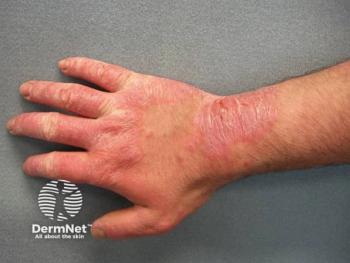
- Dermatology Times, Integrating Gene Expression Profiling Into Skin Cancer Care, September 2025 (Vol. 46. Supp. 05)
- Volume 46
- Issue 05
Leveraging Molecular Diagnostics for Tailored Skin Cancer Care
Key Takeaways
- Molecular testing, especially GEP, personalizes treatment strategies for early-stage skin cancers, surpassing traditional staging systems.
- GEP helps identify patients needing aggressive intervention, reducing unnecessary procedures and refining patient management.
Discover how gene expression profiling transforms melanoma and SCC management, enhancing personalized treatment strategies and improving patient outcomes in skin cancer care.
At an exclusive Dermatology Times
Case No. 1: Challenging Population-Based Assumptions
A 45-year-old male patient presented with a 0.6 mm Breslow depth melanoma on his plantar foot, initially classified as a low-risk T1a tumor with a 98% population-based survival rate. While statistically promising, Cotter emphasized that population-level statistics offer little comfort to patients who fall into the rare but critical 2% at risk of metastatic progression. The molecular testing approach allows clinicians to distinguish between patients who can safely undergo standard follow-up and those requiring more aggressive intervention. In this case, the i31-GEP test could help determine whether a sentinel lymph node biopsy was necessary or if standard wide local excision and clinical monitoring would suffice.
“With melanoma, you never have zero risk. There's always a possibility of something bad happening, which is why you don't want to get the question wrong. The group almost unanimously agreed to order an i31-GEP test to rule in or rule out, doing a sentinel lymph node biopsy for this patient,” Cotter explained.
Case No. 2: Avoiding Unnecessary Procedures
The second case involved a woman with an intermediate-thickness melanoma, presenting unique challenges in determining sentinel lymph node biopsy recommendations. Traditional guidelines from the National Comprehensive Cancer Network suggest considering biopsy for tumors with a 5-10% node positivity risk, but this approach can lead to costly and potentially unnecessary procedures. According to additional data, molecular testing reveals the potential to reduce unnecessary sentinel lymph node biopsies by up to 25-30%. When the i31-GEP test indicated a less than 5% risk of node positivity, patients could safely avoid the surgical intervention, representing a significant advancement in personalized cancer care.
Case No. 3: Guiding Radiation Therapy Decisions
The final case involved an 80-year-old man with a squamous cell carcinoma on the frontal scalp, initially low-risk but discovered to have perineural invasion during Mohs surgery. The molecular test became crucial in determining radiation therapy recommendations. Patients with a class 2b high-risk GEP demonstrated a significant benefit from adjuvant radiation therapy, with potential metastasis risk reduction of approximately 50%. This approach allows clinicians to tailor treatment more precisely, avoiding unnecessary radiation for low-risk patients while ensuring appropriate intervention for those at higher risk.
Cotter and the attendees also discussed broader applications of molecular testing, particularly in surveillance for node-negative melanoma patients. Despite negative sentinel lymph node results, approximately 15% of patients may still develop metastatic disease. Molecular profiling can identify high-risk patients who might benefit from more intensive imaging and early intervention.
This exclusive conversation demonstrated that precision medicine is transforming skin cancer management, keeping attendees educated and informed about these types of technologies.
By moving beyond population-based statistics and embracing molecular diagnostics, clinicians can provide more targeted, patient-specific care. As technology continues to advance, GEP represents a powerful tool in understanding individual cancer risks and tailoring treatment strategies.
“When we have the opportunity to utilize personalized medicine, we really should. That way we can refine our treatment strategies for our patients with high-risk skin cancer,” Cotter concluded.
Articles in this issue
Newsletter
Like what you’re reading? Subscribe to Dermatology Times for weekly updates on therapies, innovations, and real-world practice tips.



















